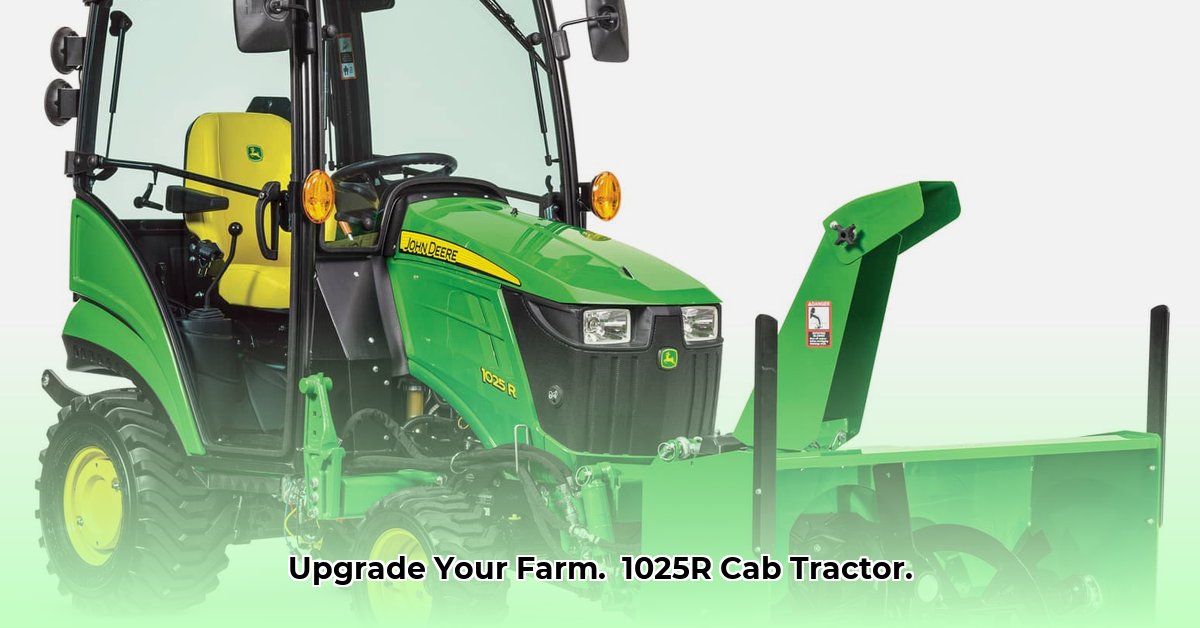
The John Deere 1025R cab tractor represents a significant advancement in compact utility tractors, offering a compelling blend of power, maneuverability, and features perfectly suited to the demands of modern, sustainable agriculture. This detailed review, incorporating practical advice and instructional elements, will guide you through its capabilities, limitations, and optimal usage.
A Powerful Package: Features and Specifications
The 1025R packs impressive capabilities into a compact frame. Its small footprint is ideal for navigating tight spaces in orchards, vineyards, and smaller fields, minimizing soil compaction—a critical factor in sustainable farming. But don't let the size deceive you; the tractor offers surprising power and versatility. Key features include:
- AutoConnect™ Deck System: (A quick-attach system for implements, significantly reducing attachment/detachment time.) Allows rapid switching between implements, maximizing efficiency. This system, coupled with the intuitive operator controls, reduces operator fatigue and increases productivity.
- Hydrostatic Transmission: (A transmission system that uses hydraulic fluid to transmit power, providing smooth and precise control.) Provides exceptionally smooth and responsive control, crucial for precise operations like spraying or cultivating delicate crops.
- Optional Cab: Offers weather protection and enhanced operator comfort, extending working hours regardless of conditions. This promotes overall operator well-being and reduces downtime due to inclement weather.
- Powerful Engine and PTO: (Power Take-Off – a system for powering implements) Delivers sufficient power for a wide array of tasks, from mowing and tilling to hauling and power-driven implements. The exact horsepower and PTO capabilities are readily available in John Deere's official specifications.
Technical Specifications: (These will vary slightly depending on configuration; consult the official John Deere specifications for complete details.) Key specifications will include horsepower, PTO horsepower, lift capacity, and fuel tank capacity.
Performance Analysis: Strengths and Limitations
The 1025R excels in tasks requiring precision and maneuverability. Its compact size allows efficient operation in confined areas, minimizing fuel consumption and soil disturbance. However, it's crucial to acknowledge limitations. This tractor is not designed for heavy-duty tasks requiring the power of larger tractors. While John Deere promotes time savings with the AutoConnect system and fuel efficiency overall, independent verification of these claims with precise data across various conditions remains somewhat limited. Further research is needed to substantiate these assertions with quantifiable metrics.
Sustainable Farming: Key Benefits
The 1025R’s design inherently supports sustainable farming principles:
- Reduced Soil Compaction: Its lighter weight significantly reduces soil compaction compared to larger tractors, promoting soil health and improving water infiltration. This translates to healthier crops and reduced need for intensive tillage.
- Increased Efficiency: The quick-attach system minimizes downtime spent changing implements, optimizing fuel usage and overall productivity. Reduced downtime directly impacts cost savings.
- Versatile Operations: The 1025R's adaptability to various implements allows for diversified crop systems on a single machine. This reduces the overall number of machines needed, contributing to a smaller carbon footprint.
- Lower Fuel Consumption (Potentially): While concrete data is still emerging, the smaller engine size and improved maneuverability suggest potential for reduced fuel consumption compared to larger tractors.
Actionable Advice: Optimizing Your Investment
For Farmers: Thoroughly assess your ROI before purchasing, factoring in the tractor's total cost of ownership, which includes maintenance, repairs, and implement costs. If possible, request a demonstration on your land to test its suitability for your specific needs and tasks.
For Dealers: Invest in comprehensive staff training on both sales and service aspects of the 1025R. Offer service packages to meet seasonal demands and ensure optimal tractor performance. Offer customer training as part of the initial purchase.
For Agricultural Consultants: Incorporate the 1025R’s capabilities into your farm management plans, emphasizing its benefits in terms of efficiency and sustainability. Conduct research to generate robust data on the tractor's impact on labor costs and environmental footprint.
Risk Assessment and Mitigation
Regular preventative maintenance is crucial for minimizing potential problems. Addressing minor issues promptly prevents them from escalating and causing significant downtime. A proactive approach in scheduling maintenance procedures will ensure years of efficient operation.
Regulatory Compliance
Adherence to all relevant safety and environmental regulations is paramount. This includes understanding and complying with ROPS (Rollover Protective Structure) standards, noise regulations, and emissions standards specific to your region. Always consult local authorities for the most up-to-date compliance requirements.
Conclusion: A Powerful Tool for Sustainable Farming
The John Deere 1025R presents a compelling option for farmers committed to sustainable and efficient practices. While it's not a solution for every farming operation, its compact size, versatility, and features make it an ideal choice for many smaller-scale operations focusing on precision agriculture and minimizing environmental impact. However, a thorough assessment of your specific needs and operational scale is absolutely crucial before making a purchase decision.